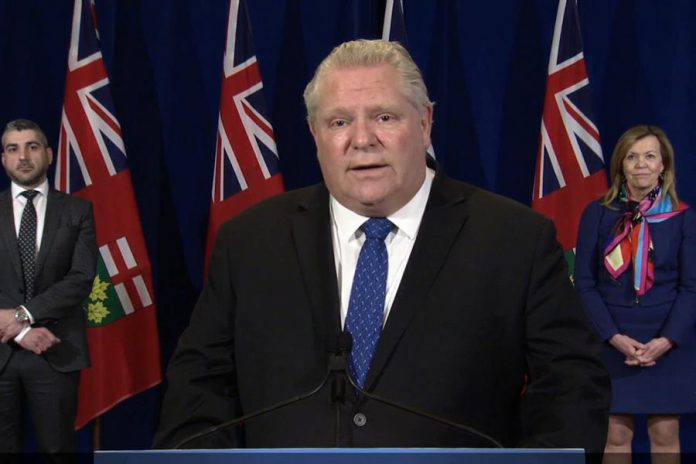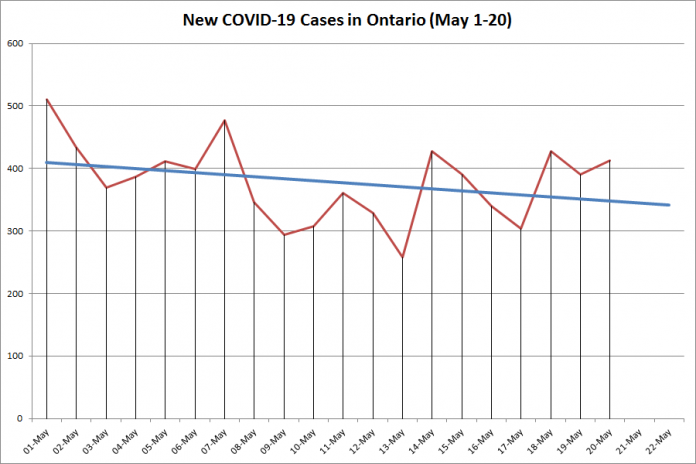
Premier Doug Ford wants to start testing as many Ontarians as possible for COVID-19.
He made the comments at a media briefing on Thursday (May 21) when the Ontario government announced its efforts to fund research and clinical trials into COVID-19 vaccines and treatments.
Over the past four days, Ontario has lagged behind its stated daily target of 16,000 tests per day, averaging around 8,200 per day.
After a reporter asked him why Ontario is not reaching the target, Ford said fewer people are going to assessment centres than expected.
“I want to see people being tested,” Ford said. “If you have symptoms, please go to an assessment centre. I repeat it, if you have symptoms, please go to an assessment centre.”
He said he wants to see testing expanded to the trucking, taxi, food processing, and automotive sectors, as well as retesting of front-line health care workers in long-term care homes.
“As sure as I’m standing here, we’re going to make sure we ramp it up,” Ford said, adding that he also wants to see testing expanded to the general population, including random testing.
“We can’t just be testing people with symptoms,” he said. “We have to start going to the broader public and start testing as many people as possible — asymptomatic people. Until we do that, we can’t get our hands around the whole system.”
“How do we know how many asymptomatic people are out there right now? If we keep testing and tracing and testing and tracing, we’re going to get it down.”
While the number of new COVID-19 daily cases has been averaging under 400 over the past two weeks, there have been a couple of recent spikes over 400.
Health minister Christine Elliott explained the increases are not related to the government’s stage one reopening of the economy, since the impact of those changes won’t be seen until next week at the earliest.

She also said that, despite the increases, the overall trend of new cases is continuing downward, but that the government is monitoring the numbers closely and, if necessary, will reintroduce restrictions.
Ford said that he’s pushing the province’s COVID-19 Command Table — chaired by the deputy health minister Helen Angus and including Ontario’s chief medical officer of health Dr. David Williams, Ontario Health president Matthew Anderson, and others — to come up with a plan for expanded testing.
“We’ll have more information next week,” Ford said. “They are going to come back with a plan, it’s all hands on deck.”
“I’ll be like an 800-pound gorilla on their backs every single day if I have to, until I see these (testing) numbers go up.”
Locally, Peterborough Public Health is encouraging all residents to get tested if they have any COVID-19 symptoms, especially if they are front-line workers.
“Our local health care system has plenty of capacity to test residents with symptoms in our community,” said Peterborough’s medical officer of health Dr. Rosana Salvaterra. “With more businesses and services reopening, it is particularly important for those resuming their front-line roles to watch for symptoms and stay home if any develop. Instead, they should get tested as soon as possible.”
The most current list of COVID-19 symptoms includes:
- fever (greater than 37.8°C / 100°F)
- new or worsening cough
- shortness of breath
- difficulty breathing
- sore throat
- headaches
- diarrhea
- chills
- runny nose/nasal congestion without other known cause
- nausea/vomiting
- pink eye (conjunctivitis)
- difficulty swallowing
- unexplained fatigue/malaise/muscle aches
- abdominal pain
- decrease or loss of sense of smell or taste
Dr. Salvaterra noted that testing is available and encouraged for anyone who has symptoms. For those who work in a public-facing capacity, she recommended checking their temperature daily, and at the first sign of illness, to stay at home and not go to work.
If you think you may have COVID-19 symptoms or have been in close contact with someone who has it, first self-isolate, and then use Ontario’s self-assessment tool at covid-19.ontario.ca/self-assessment/ to see if you need to seek further care.
If you need further assistance, call your local health unit or local COVID-19 Assessment Centre.


























